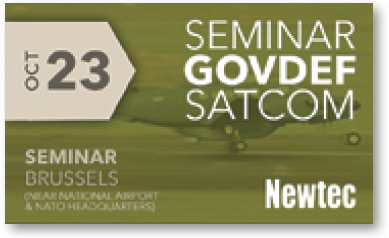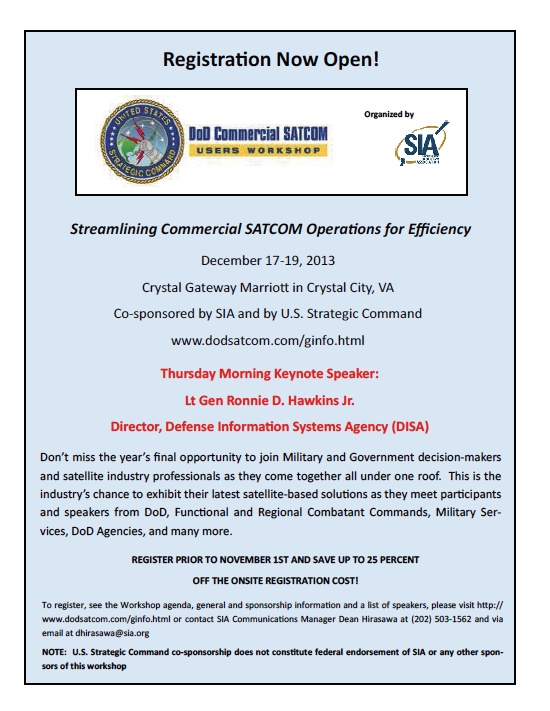As the release date for the new standard by DVB for satellite communications (S2 Extensions) approaches, all markets, including Government and Defense, are starting to assess the relevance of switching their operations towards the new standard.
The question of how important the new standard will be for the Government and Defense market is now surfacing. We will try to find some answers to their concerns by having a closer look at the S2 Extensions technology and using the data from a market survey carried out at the beginning of 2013.
Back in 2005, the SATCOM community was convinced that DVB-S2 would be the ultimate satellite modulation standard and no significant upgrades would be possible. Since that time, the satellite communications market has certainly changed. Higher speeds, more efficient satellite communication technology and wider transponders are required to support the data and video hungry applications now transmitted over satellite. We drew lessons from other communication industries and benchmarked with cable and wireless technologies. Bright engineers came up with new ideas. Finally, the outcry from the market for more efficiency to ensure satellite operations remained profitable convinced DVB to start working on the standardization of S2 Extensions.
Newtec has taken the lead and teamed with other DVB members in order to define and develop the update of the DVB-S2 standard. At this point in time, the DVB organization has already approved the commercial and technical requirements for the new standard and is currently at the stage of formalizing the standard for publication. The successor to the DVB-S2 standard for satellite communications will be launched in the fourth quarter of 2013.
S2 Extensions Technology Improvements
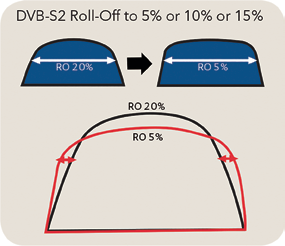
Newtec’s contribution to the new standard (here referred to as S2 Extensions—however, the name of the standard is still to be decided by DVB) has resulted in a number of candidate technologies. For the satellite community, the creation and adoption of new S2 Extensions will translate into better efficiency, higher speed and improved service robustness. These extensions have the potential for as much as a 37 percent improvement on top of current standards. This jumps up to 64 percent or more with 72MHz wideband transponders. The new standard has seven main improvements when compared with DVB-S2.
Improvement 1: Lower Roll-Offs
A first innovation inside the new standard implements a smaller Roll-Off (RO) percentage than is currently used in the DVB-S2 standard. In the DVB-S2 standard, the 20 percent and 25 percent RO percentages are common and are an integral part of the modulated carrier (i.e., symbol rate plus RO). Reducing RO to 5, 10 and 15 percent results in a direct gain in bandwidth. Looking at the spectral image when implementing smaller ROs, the slope of the carrier becomes steeper when compared to DVB-S2 but still fits nicely in the allocated bandwidth. The efficiency gain by implementing smaller ROs can go up to 15 percent.
Improvement 2: Advanced Filtering For Improved Carrier Spacing
The second innovation deals with noise levels (side lobes) on both sides of the carrier. These side lobes prevent satellite carriers from being placed close to each other. Applying advanced filter solutions in S2 Extensions has an immediate effect on bandwidth savings, as the spacing between carriers can be as close as 1.05 times their symbol rates (or even closer, in some specific use cases). Please note that even with 35, 25 and 20 percent ROs, better filtering results are obtained.
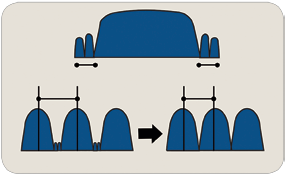
Improvement 3: Supporting Different Network Configurations
The RO and filtering innovations within the new standard can be applied in satellite links with single carriers (mainly RO effect), multiple carriers (filtering and RO effects) or carriers sharing the same transponder with other providers. In the latter case, S2 Extensions carriers can easily co-exist with adjacent carriers from other operators within the same transponder. The improved ROs and filtering technologies are only applied on the allocated carriers. Neighboring carriers will not be affected and do not notice any form of interference.
Improvement 4: Increased MODCOD Granularity
The number of Modulation and Coding standards (MODCODs) has grown from 28 in DVB-S2 to as many as 87 in the S2 Extensions, bringing efficiency as close to the theoretical Shannon limit as possible. The Shannon limit is the maximum rate at which information can be transmitted over a communications channel of a specified bandwidth in the presence of noise. By introducing an increased granularity, the highest resolution for optimal modulation in all circumstances can be provided. The current DVB-S2 quantization steps are quite far apart. By adding granularity in the upcoming standard the service provider can further optimize the satellite link—depending on the application in use.
Improvement 5: Higher Modulation Schemes Up To 64APSK
Adding higher modulation schemes such as 64APSK (Amplitude and Phase-Shift Keying) proves to be useful, considering the professional applications that work with improved link budgets provided by, for example, bigger antennas (and more powerful satellites as they become available). Newtec sees the 32APSK boundary being reached frequently with its auto-adaptive FlexACM® technology during clear weather conditions. In these situations, 64APSK is highly beneficial. When combining the increased granularity (MODCODs and FECs [Forward Error Correction]) and 64APSK (higher order modulation and coding) immediate efficiency gains up to 37 percent can be achieved as compared to DVB-S2.
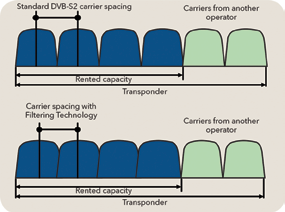
Improvement 6: Better MODCOD Implementation
Compared to DVB-S2, the MODCODs themselves have been improved in S2 Extensions to achieve even better efficiencies. S2 Extensions also have two different classes for linear and non-linear MODCODs. As the DVB-S2 MODCODs are focused on Direct-to-Home Broadcast (DTH), the constellations are well suited for distribution applications with quasi-saturated transponders. For high-speed data and video exchange applications, other constellations can be considered where the performance gain is larger than 0.2dB. Although the MODCODs might use the same code/name, the linear and non-linear MODCODs are not interchangeable.
Improvement 7: Wideband Implementation
The S2 Extensions support technology for typical wideband transponders that become/are available today hosting high-speed data links. The wideband implementation in S2 Extensions typically addresses satellite transponders with bandwidths from 72MHz (typically C-band) up to several hundred MHz (Ka-band, HTS [High Throughput Satellite]). In principle it would be possible to allocate several narrower channels inside the wideband transponders. However, such would require the operation of the satellite transponder with reduced downlink power and, therefore, at sub-optimal efficiency. The S2 Extensions demodulator will receive the complete wideband signal resulting in a very high data rate.
S2 Extensions Results and Efficiency Gains
When comparing the current DVB-S2 standard against the full implementation of S2 Extensions (activating smaller ROs, advanced filtering, 64APSK), staggering efficiency gains up to 37 percent can be achieved for professional applications over satellite. In links using wideband transponders, an extra 20 percent gain can be added. These gains already exceed the results of proprietary systems in the market today.
Why Are S2 Extensions Relevant to the MILSATCOM Market?
Now that we have an idea about the involved technologies in the new DVB standard for satellite communications, we can discuss the benefits for MILSATCOM applications and draw conclusions on the relevance of S2 Extensions for the market.
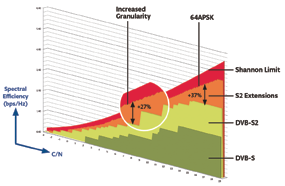
Having a standard in the first place improves interoperability between different government and defense departments, increasing the effectiveness of operations in the field. Moreover, an open standard avoids vendor lock in and allows multiple vendors to enter the network, lowering the overall risk of high pricing, companies going bankrupt, or non-availability of spare parts.
Efficiency gains as demonstrated by the different technologies inside S2 Extensions provide more throughput in the same available bandwidth. With the increase of data, video and voice traffic over MILSATCOM links (example for ISR [Intelligence, Surveillance and Reconnaissance]; and MWR [Morale, Welfare and Recreation] applications) and a lack of available bandwidth over some ‘hotspot’ regions, technologies that cater for extra throughput are welcomed. By switching modulation schemes from DVB-S2 towards S2 Extensions, as much as a 37 percent gain can be achieved. The new standard does not only apply to high data rate applications. Even at lower modulation and coding (QPSK/8PSK) levels, 10 percent improvements can be achieved.
To mitigate the increase in MILSATCOM data rates, government and defense departments have invested in high throughput satellites such as the WGS constellation (Wideband Global Satellite). With Wideband implementation in S2 Extensions, large carriers can be received by the demodulators, adding an extra 20 percent efficiency.
Even in satellite links suffering from fading, interference or shadowing effects (partly blocking of antenna), better throughput can be obtained with S2 Extensions in combination with ACM (Adaptive Coding and Modulation). With the increase in granularity in MODCODs in S2 Extensions, the jumps between MODCODs are not as large as in DVB-S2. As such, the ACM can smoothly glide down in MODCODs when the satellite link encounters fading conditions and provide optimal throughput at all times.
Applying ACM in combination with S2 Extensions also helps to achieve maximum service availability. In deep fading scenarios where DVB-S2 normally would have dropped the satellite link, S2 Extensions provide additional, lower MODCODs with the exact objective of increasing the service availability and keeping satellite links alive. Robust MODCODs such as π/2 BSPK ¼ Spread 2 and very low SNR (Signal–to-Noise) implementations will avoid the satellite link to drop even in the harshest circumstances (e.g., partly shadowing of antenna by tail or wings in airborne ISR missions). As such, the ACM technology can make use of the very low MODCODs and maintain satellite link uptime in deep fading situations. The risk of endangering the mission will be greatly reduced by switching technology to the new DVB standard.
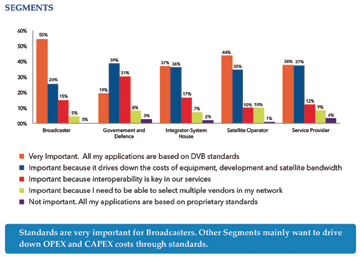
What effect does the new standard have on the operational (OPEX) and investment (CAPEX) costs? S2 Extensions do come with a price tag, as the standard is not backward compatible, but compared to the gains (more throughput in same available bandwidth) and savings (save on bandwidth with the efficiency gains) that can be achieved, the price discussion dissolves immediately. Moreover, switching to the new standard does not mean that the entire infrastructure needs to be immediately replaced. Different migration paths towards the new standard are possible.
– First, it is possible to put a part implementation of S2 Extensions on existing Newtec equipment in the field. In that scenario, also called Clean Channel Technology, lower roll-offs (5, 10, 15 percent) next to advanced filtering technologies are activated through a software update. Gains up to 15 percent are now in reach of the MILSATCOM operator with this software only upgrade.
– The second option is to put a Newtec S2 Extensions modem with the Transmodulation technology enabled in front of the existing infrastructure. In that scenario, the satellite link is optimized with the S2 Extensions efficiency. The aggregated data is sent over a Multistream carrier from the uplink to the remote location and separated again based on the ISI (Input Stream Identifier) of the baseband frames. The Newtec modem trans-modulates the waveform from S2 Extensions towards DVB-S/S2 and sends it through to the existing infrastructure of IRDs, legacy receivers etc.
In conclusion, a new DVB standard that takes into account interoperability, allows more throughput in the same bandwidth and assures maximum service availability is definitely relevant to the MILSATCOM market. Moreover, S2 Extensions are ready to deal with the upcoming high throughput satellites and takes cost, plus savings, into account in these times of government budget cuts.
Polling the MILSATCOM Market Opinion About The New Standard
In order to gauge the temperature of the SATCOM sector, Newtec carried out an extensive industry survey at the start of 2013. More than 700 respondents from 400 companies and organizations answered questions on the launch of S2 Extensions for the satellite market. An important share of the answers came from experts involved in the MILSATCOM sector.
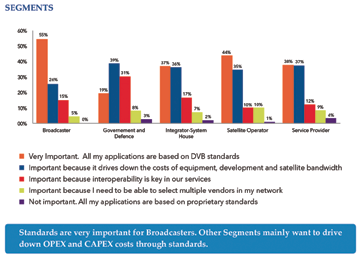
Key Findings 1: How Important Are Standards?
The first question polled the community on the importance of having standards in the satellite communications industry. The main finding that could be derived from the first question revealed that 97 percent of the MILSATCOM respondents consider having standards to be important or very important. The main motivation for the MILSATCOM experts was that standards, such as DVB-S2 and S2 Extensions, drive down the cost of equipment, development and satellite bandwidth. Secondly, interoperability is a key requirement for the majority of government and defense SATCOM networks.
Key Findings 2: Switch-over Timeframe to New Standards
In the second question of the survey, the satellite community gives a timing indication of when the industry will switch towards the new standard. As DVB-S2 is currently the widely accepted standard in government and defense markets for SCPC links, it will take a standardization process through governmental bodies (such as DISA) before the majority of the satellite links can be migrated towards S2 Extensions. Hence, the majority share of government and defense representatives answered that they would rather wait one or two years after the launch of the new standard before making the switch.
Still, 33 percent of the MILSATCOM survey takers would switch to S2 Extensions within one year of the launch when acquiring new equipment. The incentive of having higher throughput and better service availability are critical for some government and defense missions that lack satellite bandwidth to efficiently perform their activities, or those that cannot afford to lose satellite links during operations.
Key Findings 3: Required Efficiency Level to Switch to New Standard
Government organizations, MODs and companies in the satellite communications industry will not switch to a new standard just for the sake of making the switch. Of the respondents, 73 percent from the government and defense market will transfer their operations to the upcoming DVB standard if the combination of technologies would allow them to win 15 to 20 percent efficiency.
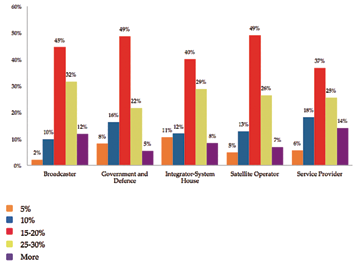
As described earlier in the article the diverse technologies inside S2 Extensions will bring satellite links up to a gain of 37 percent. The first candidates for migration are most probably the high-speed data and video MILSATCOM links for ISR, MWR or strategic satellite links. Still, the spectral efficiency improvements also apply to operations that have lower throughput demands with efficiency gains starting at 10 percent. (Please see the corresponding chart on the next page.)
Key Findings 4: What Would your Organization/Company Do with the Extra Bandwidth?
The final question polled what the different Government and Defense organizations would do with the extra-obtained bandwidth by implementing S2 Extensions. The majority (47 percent) of the satellite experts will use the extra bandwidth to increase their throughput. The second answer exposes the opportunity to grow their number of services. Interestingly, the desire to cut OPEX savings only represents 11 percent of the answers. (Please see the corresponding chart on the next page.)
Conclusions
The satellite industry has come to a consensus that a successor to the DVB-S2 standard is required to accommodate increased profitability, interoperability and growth in the professional satellite communications market. Throughout the article we have demonstrated that S2 Extensions will be relevant for the government and defense market as well.
The different technologies inside S2 Extensions will bring an efficiency optimization up to 37 percent in a MILSATCOM link. Adding wideband to the equation to support upcoming high throughput satellites provides another 20 percent gain. These gains will help MILSATCOM operations to obtain more throughput over the same available bandwidth to support their data hungry applications such as ISR, MWR or exchange of strategic information. Other benefits that go along with switching operations to the new standard are increased satellite link uptime and maximized service availability, as well as taking government budget-cut reality into account by achieving impressive savings with little capital investment costs.
The majority of the MILSATCOM community will migrate their operations as from one year after the launch of the new standard in Q42013. That is the exact timing to get S2 Extensions formalized by MILSATCOM authorities, such as DISA. Some operations that are already suffering for lack of bandwidth, or do not receive sufficient service availability to support their activities, will immediately switch to the new standard.
Newtec’s contribution to the new standard consists of a number of technologies including:
– Smaller roll-offs
– Advanced filter technologies
– Increased granularity in MODCODs
– Higher Modulation up to 64APSK
– Better Implementation of MODCODs
– Wideband (72Mbaud)
The Newtec MDM6000 and MDM6100 modems and the HUB6000 Satellite Hub already integrate these technologies. In combination with Newtec efficiency technologies, such as FlexACM®, Automated Equalink®, Bandwidth Cancellation and Cross-Layer-Optimization, these S2 Extension ingredients bring the MILSATCOM links to full efficiency achieving barrier breaking throughputs at maximum service availability.
By downloading the Newtec S2/S2 Extensions Calculator (http://www.newtec.eu/services-training/dvb-s2-calculator), the MILSATCOM community can already compare DVB-S2 with the new standard and measure link budgets on existing and upcoming satellites. The calculator can be found on the Newtec website by following link: www.newtec.eu/services-training/dvb-s2-calculator. For further information on S2 Extensions, please download the white paper ‘Demystifying S2 Extensions’ for more technical insights and the S2 Extensions Survey results Ebook via the dedicated online webpage: www.newtec.eu/technology/s2-extensions.

About the author
Koen Willems started his career in 1998 with Lernout & Hauspie as a project manager in the Consulting and Services division. More recently, he joined Toshiba as a Product Marketing Manager for the Benelux and, later, for the European market. In a total of six years, Koen contributed to all of the major Toshiba Retail IT product releases. Mr. Willems is currently the Market Director for Government and Defense for Newtec, a Belgium-based specialist in satellite communications. Koen holds a degree in Germanic Languages (University Ghent, Belgium, 1997) and completed a Masters degree in Marketing Management program at the Vlekho Business School in Brussels (1998). He acquired a Six Sigma Black Belt for product development and process improvement in 2006. Koen is also a member of the Board of Directors for the Belgian Security & Defense Industry (BSDI).
Newtec Government and Defense SATCOM Seminar on October 23rd in Brussels, Belgium
On Wednesday October 23rd, 2013, Newtec will host a Government and Defense Seminar in Brussels on the topic of satellite communications, efficiency and best practices in the market.
As you read in this feature article, the Government and Defense SATCOM market are craving for more bandwidth in order to support their operations.
A key requirement for the satellite link in applications such as ISR (Intelligence, Surveillance & Reconnaissance) networks, airborne surveillance and MWR (Morale, Welfare and Recreation) is to get as much data and video as possible through the available bandwidth. The satellite link also needs to be available at all times during operations to insure mission critical communications and not endanger ground operations.
During the seminar, SATCOM experts from different companies and organizations (NATO, Intelsat, SES, SniperHill, Hitec and Euroconsult) will offer their views on the challenges, trends and solutions that exist in the Government and Defense market today.
You will have the opportunity to learn more from customer use cases, innovative SATCOM technology updates, and market views that will impart some bright new ideas to implement in your SATCOM network or solution offering.
Check the agenda and register for the Government and Defense Brussels event via the following link:
http://www.newtec.eu/event/government-defense-satellite-communications-seminar


